NOSTALGIA ALERT! The Lion King (2019) delivers a relatively agreeable film. From catchy show tunes and comic gems, the 2019 Disney blockbuster delivers fresh dialogue, while subsequently providing alternative references to modern pop-culture. Although some iconic moments are altered, the alternative provides new perspectives on the tale we have come to know and love. Although this is the case for the majority of the film, there are a few shortcomings as well. Let’s dig in:
*** DISCLAIMER: The thoughts and opinions below are mine alone. You have the right to agree or disagree. I am not here to argue, but rather state my review on the 2019 adaption. These are my thoughts and opinions on the matter. Keep in mind there are many spoilers below, you have been warned***
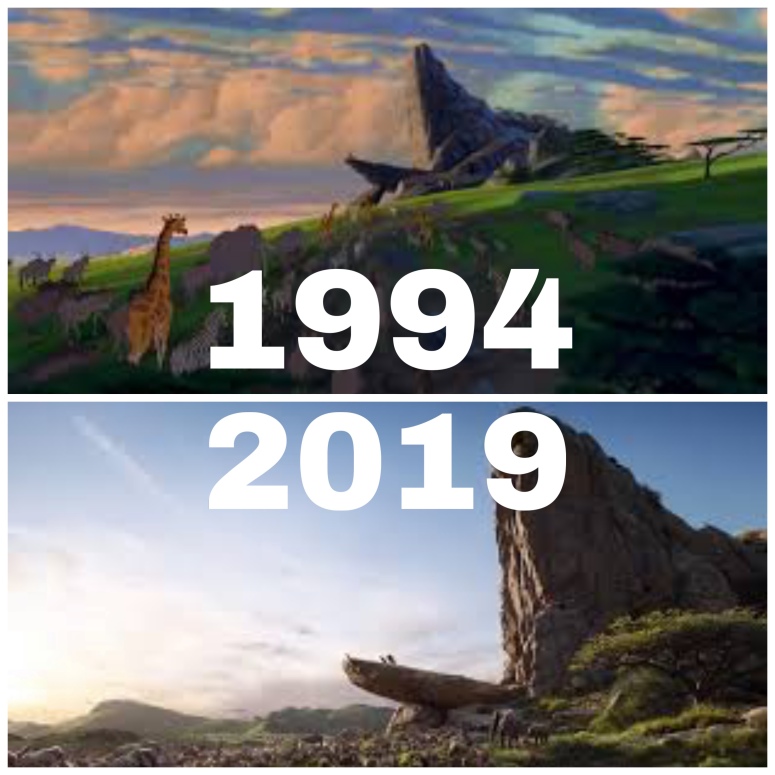
The First Image
The first image in a film is incredibly important. It not only sets the tone of the film, but also determines the first impression. The first image means more than the literal first shot, although that is important too. Instead, the first image encases the first scene.
The film starts with the iconic “Circle of Life.” The powerful vocals provide an eclectic opening scene to the film. Cinematography is almost an exact replica to the original 1994 film. Simba is presented for the first time as the cutest little CG Lion cub ever. Nostalgia hits hard and thankfully I was too preoccupied with the song to mind the overly realistic character design. As the melody escalates and the notes ring their last tune, “The Lion King” boldly flashes across the screen with the iconic heavy hit that accompanied the original score. This technique was used to hype the audience, and it worked.
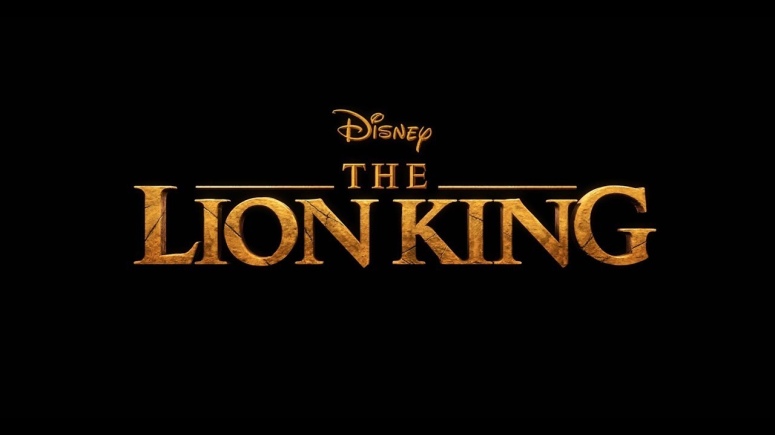
Although a mirror to the original, I feel as though it would have played even better if the camera movement was continuous. As the camera moves spatially backwards from pride rock, I would have liked to see the camera fluidly, in a sweeping downward motion, meet and track the little mouse traversing the terrain.
Having the camera track in this manner would enable the juxtaposition of time and meaning, effectively tying together The Circle of Life to the narrative. Instead we see Scar plucking at the little scared mouse without a time reference. In film, really media of all sorts, fade to black transitions and cross dissolves are reserved to indicate the passage of time. Even though it can be used stylistically in montages and at the beginning or end of the film, that is besides the point. The point is that the decision to fade to black, after The Circle of Life, was ill timed. The bottom line, in my humble opinion, is that the use of this technique distorted time. Mufasa’s dialogue
Scar, I didn’t see you at the presentation of simba this morning
—Mufasa
was the only frame of reference. By breaking up The Circle of Life from Mufasa questioning Scar, via a cut to black -fade from black,- the filmmakers are effectively extending the first image. The scene bleeds over as a result. The Circle of Life now appears as a form of exposition rather than the change it brings to the animal kingdom. This extension makes for a weak first image, especially when compared to what it could have been, strictly opening with The Circle of Life. Many could argue “but that is what they did in the original” and I would briefly be swayed. But, as filmmakers, we are tasked with using techniques to make it our own. If they are not going to add any new perspectives or modern techniques then why are they recreating a Live Action rendition of a Disney Classic? (Lets set aside money and the current state of affairs regarding Disney’s monopolization). I know it is such a small alteration, but subconsciously it would have made a significant difference.
Also, having the title card at the beginning, and later discovering it at the end, was unnecessarily redundant. We all know that we are watching The Lion King, lets not waste screen time on title cards.
Scar’s Backstory
A new addition to the 2019 adaption comes in the form of a relevant and intriguing backstory, Scar’s backstory. In scene 1 we see Mufasa confronting a mangey Scar about missing Simba’s presentation that morning. It is then, via dialogue, that Scar discusses his underlying antagonism and alludes to the manner in which he received his moniker and appearance. Apparently many years ago, Scar had challenged King Mufasa for the right to rule and preside over Pride Rock. During this challenge, Scar had gained his new facial adornment, his scar.

A brilliant addition to Scar’s character, this backstory explains so much. It also adds a realism to his hatred and malicious scheming. The backstory makes so much sense, flows with the story, and provides reasonable motive for Scar’s actions. I love it. It just makes so much sense (read “Scar’s Reign,” featured below, for more details into his backstory).
Hesitancy with the Characters
Upon introduction to the 2019 Zazu, I became immediately hesitant and even worse … worried. With his first line, I feared his only purpose was to provide unnecessary exposition, a tireless and annoying crutch a lot of filmmakers lean upon. Alongside this, I also feared his beady realistic eyes would fall short. Emotion, beyond malice and cunning, is almost impossible to convey via beady little bird eyes. Thankfully, casting John Oliver and his deliverance of Zazu’s dialogue helped paved the way for this iconic character.

Zazu’s character brought plenty of laughs while giving Mufasa and Simba the opportunity to bond over a little harmless antagonism. As a result of assisting in character and relational development, I will give Zazu two thumbs up.
In addition, his scoff and exclamation
It’s the news!
— Zazu
brought a much needed laugh in the theater, especially considering the current political climate. It was such a light hearted moment and the first of many cultural references. Honestly, this dialogue was one of my favorite Zazu lines.
Then, there are the loveable sidekicks, Timon and Pumba. Upon the release of their character design, I was immediately concerned. Pumba looked much more scraggly and Timon was much more dorky. In fact, I highly disliked their “look.” However, the acting for both of these characters made up for it, even if Timon was a bit over the top at times. It matched and it worked. 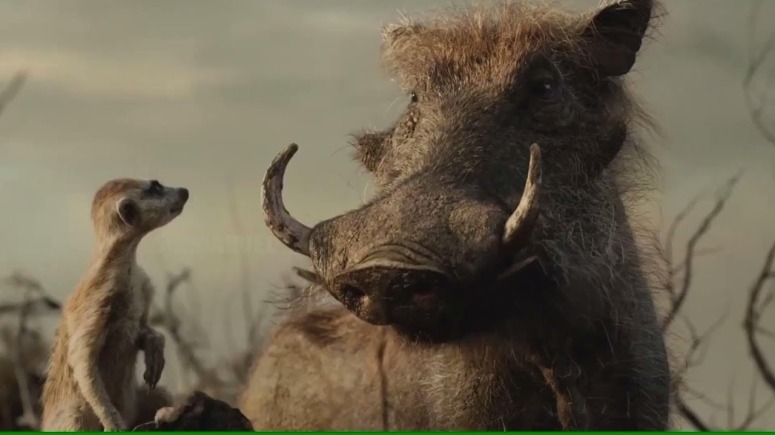 Not necessarily the same as the original ’94 characters and cast, but it worked. At this point in the film too I had to acknowledge that the style was set and the filmmakers had no choice but to visually depict Timon and Pumba in this overly realistic, cringe-like manner (Sorry Pumba). Although this is the case, I do appreciate the attention to detail they put into Timon’s habits. He habitually scratches and shakes himself out, almost like a dog. This paired with his instinctual combing through Simba’s mane looking for bugs just brought even more realism to his character. His purpose for doing it isn’t influenced by a plot device, but rather the desire to bring a character to life. That in itself deserves recognition. Pumba’s loveable character shined through, even though he has a not so pleasant exterior … for successfully demonstrating this foil, I also give kudos. Pumba is just as sensitive and lovable as ever, a perfect sidekick to our “know-it-all” Timon.
Not necessarily the same as the original ’94 characters and cast, but it worked. At this point in the film too I had to acknowledge that the style was set and the filmmakers had no choice but to visually depict Timon and Pumba in this overly realistic, cringe-like manner (Sorry Pumba). Although this is the case, I do appreciate the attention to detail they put into Timon’s habits. He habitually scratches and shakes himself out, almost like a dog. This paired with his instinctual combing through Simba’s mane looking for bugs just brought even more realism to his character. His purpose for doing it isn’t influenced by a plot device, but rather the desire to bring a character to life. That in itself deserves recognition. Pumba’s loveable character shined through, even though he has a not so pleasant exterior … for successfully demonstrating this foil, I also give kudos. Pumba is just as sensitive and lovable as ever, a perfect sidekick to our “know-it-all” Timon.
Let’s talk about these hyenas. What a change. I will say that I do miss Whoopi Goldberg’s Shenzi. The 2019 version didn’t have the comedy, the slyness, the sex appeal that the ’94 adaption did.

Just look at the comparison of the character designs and you will understand what I mean. The Shenzi of ’19 has a clear leader role. She doesn’t tolerate mistakes and doesn’t cower to Scar like the ’94 adaption.
character designs and you will understand what I mean. The Shenzi of ’19 has a clear leader role. She doesn’t tolerate mistakes and doesn’t cower to Scar like the ’94 adaption.
Shenzi: I just hear that name and I shudder.
Banzai: Mufasa!Shenzi: Ooooh! Do it again!Banzai: Mufasa!Shenzi: Ooooh!Banzai: Mufasa, Mufasa, Mufasa!Shenzi: Ooooh! [breaks into laughter]Scar: I’m surrounded by idiots.— Lines from the ’94 adaption
In contrast, the 2019 Shenzi demands respect. She would not tolerate Scar’s less than complimentary commentary. Due to this development Scar’s iconic line was omitted from the film. Did it really make that much of a difference? Considering that he calls them fools instead, I would say it depends on personal preference. The major difference resides within character development and the actions that are depicted. As a result of Shenzi’s character alteration, the perception of the hyenas change. Now, the emphasis sits heavy on their scavenger nature. They are rougher around the edges and lose their previous stigma. Instead of being the butt of the jokes and reflecting the light hearted comedy of the ’94 adaption, they are the ones using brute force in conjunction with Scar’s cunning to oppress the pride. They defy King Mufasa and will later wreak havoc on the pride lands and Scar himself. In fact, it can be argued that Scar is nothing without his hyena army. Although I miss the old characterization, this alteration makes a lot of sense. Scar is a cunning villain.
You fools have stripped your land of every living thing, and yet I send two little cubs your way …
… why eat one meal when you can be feasting for the rest of your lives, a place where you can fill your bellies … Where everything the light touches is yours.
— Scar ’19
He is the only Disney antagonist that successfully kills an opponent. In order to take Scar down, the film needs a strong force that distributes an appropriate consequence for the sins committed. As a Disney film, the protagonist cannot kill the antagonist. This act would show Simba in a negative light. Thus, they had Simba battle Scar, win, and show mercy. Simba offered to save his Uncle Scar’s life. But Scar, determined to take Simba down, attacks our new found king, slips, and in an ironic karma filled sequence of events, Scar falls to his doom … off a cliff … just like Mufasa. The twist of the matter is that he survives the fall. Why? Because his death cannot be directly caused by Simba. Simba is the good guy and it violates the Disney code of ethics for Simba to cause the death of his uncle.
At the bottom of the cliff, Scar struggles to his feet. Upon standing, he is met with an angry Shenzi.
There was only one true thing you ever said Scar, a hyenas belly is never full.
— Shenzi Line from the ’19 adaption
This would not have had the impact it does if Shenzi wasn’t required to be a strong leader. The meaning of this story-beat intensifies as a result of the new characterization Disney gave to this new era of Hyenas. The irony of Scars death satisfies the audience as it is alluded that the Hyenas eat Scar. He is no more.
Although the Hyenas have a stronger image, they also still have comedic beats. Even though they are sparse, the filmmakers preserved some comic intent. Rather than having Banzai (Cheech Marin) and Ed (Jim Cummings), they renamed our hyena duo to Azizi and Kamari. Both hyenas talk in this adaption. Disney discarded the idea of having a mute, agreeable, and slightly crazy hyena. Instead, you can find Azizi to be a large cuddle-bug. He constantly invades Kamari’s personal space, much to Kamari’s displeasure. Basically, Azizi is every pet owner who wants to cuddle with their little furry house guest, and Kamari is the pet that endures but lets his annoyance be known.
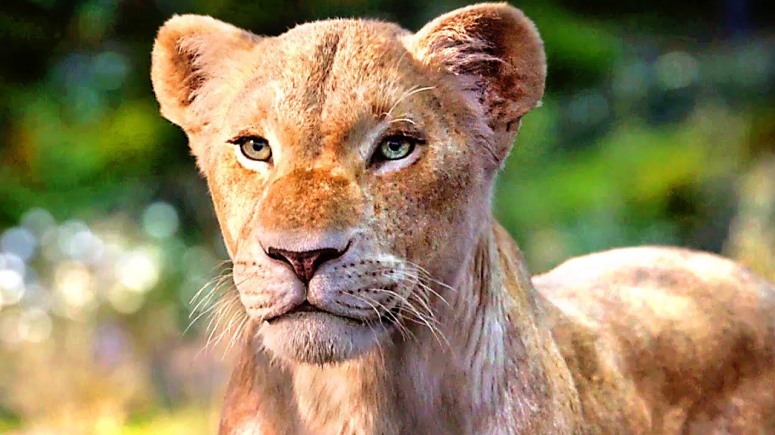
Moving on to Nala, Beyoncé the queen herself received the honor of bringing this fierce lioness to life. Upon the announcement, I was beyond excited. It was the perfect casting choice. Nala’s strength was excellently portrayed.
 After failing to appropriately portray female empowerment in the live action remakes of Beauty and the Beast and Aladdin, (I’ll save that for another blog post), Disney finally got it right. For the first time in this female empowerment era, Disney didn’t push an agenda. Nala’s strength, leadership, and fierce personality flowed effortlessly on the screen. Nothing was forced or unnatural in the acting and portrayal of Nala as a character. I do only have one issue with Beyoncé’s portrayal (sorry Beyoncé fans), but I will save that discussion for the musical number category in a little bit, scroll down to read that.
After failing to appropriately portray female empowerment in the live action remakes of Beauty and the Beast and Aladdin, (I’ll save that for another blog post), Disney finally got it right. For the first time in this female empowerment era, Disney didn’t push an agenda. Nala’s strength, leadership, and fierce personality flowed effortlessly on the screen. Nothing was forced or unnatural in the acting and portrayal of Nala as a character. I do only have one issue with Beyoncé’s portrayal (sorry Beyoncé fans), but I will save that discussion for the musical number category in a little bit, scroll down to read that.

Simba! The lion of the century! Or two centuries I suppose given his introduction in 1994 and his rerelease in 2019. Brought to life by Donald Glover, whom I have been following ever since his time on the sitcom Community, gives spirit to our protagonist.  Simba is a character filled to the brim with curiosity, but he also has a much deeper side to him as well. Not only does he develop into a courageous and righteous leader, but he struggles with doubt and guilt. Both of these qualities relate to the human experience, therefore making Simba a dynamic and complex character, a character that grows into his role. He learns to become his own leader based on the knowledge passed down to him from his father, and then he shapes his own judgement through his own experiences. After living the Hakuna Mata philosophy through his adolescents, he eventually finds a balance where his past and present philosophies can co-exist. This is detrimental. It shows a healthy manner in which a character adapts and merges two different lifestyles to find inner emotional peace, a feat that many people even today struggle to comprehend.
Simba is a character filled to the brim with curiosity, but he also has a much deeper side to him as well. Not only does he develop into a courageous and righteous leader, but he struggles with doubt and guilt. Both of these qualities relate to the human experience, therefore making Simba a dynamic and complex character, a character that grows into his role. He learns to become his own leader based on the knowledge passed down to him from his father, and then he shapes his own judgement through his own experiences. After living the Hakuna Mata philosophy through his adolescents, he eventually finds a balance where his past and present philosophies can co-exist. This is detrimental. It shows a healthy manner in which a character adapts and merges two different lifestyles to find inner emotional peace, a feat that many people even today struggle to comprehend.
Before my viewing experience I was extremely nervous about the emotive energy and portrayal of these characters. Emotion shines through the eyes. Although animals experience emotion, their range of emotion is much more limited. As a human we recognize the look of happiness, sadness, pain, anger, confusion, and maybe disgust in our pets. But to artificially recreate these in CG form … to manipulate the pixels, the angles, the depth … it was a deep concern of mine. I feared the emotions would be shallow. For the most part everything worked … except for the most important moment in the entire film … Mufasa’s death.
Mufasa’s Death

Character development is fundamental in any film, but when you kill off the king, the unstoppable authority, character development becomes a science and an art. Leading up to Mufasa’s death, we see the hearty lion play dad, joke with his “wife,” kick some hyena ass, and reprimand the villain. He asserts his authority, yet understands the value of morality, ethics, and protecting the ebb and flow of the circle of life. Mufasa doesn’t fear anything, that is until Simba disobeys him, visits the elephant graveyard, and walks right into the hyenas’ den. In good old Mufasa fashion, he comes to the rescue. Repeatedly Mufasa is shown as an unstoppable force. This builds up his character and creates an even larger “shock” value when the unthinkable happens, Mufasa dies. Of course those who are familiar with the tale have the foresight of what is to come, but the lead up still makes a strong impact. Mufasa’s biggest fear is the safety and wellbeing of Simba. Scar uses this knowledge against him. A stampede in the dome leaves Simba alone and fighting for his life, but not for long. Mufasa arrives on the scene, saves the little cub, gets knocked around a little bit by the fleeing antelope, and climbs up the cliff. By the time Mufasa reaches the top, he is barely holding on. Hope is found when he sees his brother standing above him. He implores Scar for help, and, in classic Scar fashion, he grabs Mufasa’s paws and proclaims
Long live the king,
— SCAR
Scar swats at Mufasa’s face in an unexpected yet somewhat ironic turn of events. This small deviation from the original ’94 adaption hit a whole different level of cruel. The shock value was unbelievable. I think it has a lot to do with the amount of pride and value that we place in our face, plus if you include the amount of vulnerability there too; it is bound to hit differently (pun not intended). For the first time in this film we see the extent of Scar’s villainy, the extent of his evil. To swat at the face of a struggling brother, a father, a king … it is beyond comprehension. 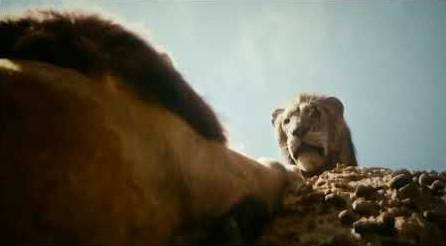 Yet, the knowledge of Scar’s motives and his backstory makes the scene even more dramatic, ironic even since Mufasa gave Scar his facial adornment and now Scar is “returning the favor.” Mufasa falls to his death. Throughout the entire scene the emotions were real, the shock was there even with having foresight. The scene looked as though it could compete with the ’94 version …. that is until Simba reached his fallen father. My biggest fear came to life in just moments. The emotions fell flat. Both baby Simba’s voice acting and visual CG rendering fell incredibly short. The emotions were shallow. The biggest moment, the inciting incident of the film, was weak. I looked into the little lion cubs eyes, and I didn’t feel nor see the devastation of a son losing a father. The fact that Simba saw it happen, would later feel guilt about his father’s demise… the biggest emotional beat in the story was hallow. It’s all in the eyes and the animators failed. In an ironic twist though, you can look into the cunning eyes of Scar during this scene, as he is convincing Simba that it is all his fault, and see the intent and emotion there. It could be argued that showing ill intent is easier than showing pain and sadness, but that gives no excuse for the portrayal of emotion in this iconic scene.
Yet, the knowledge of Scar’s motives and his backstory makes the scene even more dramatic, ironic even since Mufasa gave Scar his facial adornment and now Scar is “returning the favor.” Mufasa falls to his death. Throughout the entire scene the emotions were real, the shock was there even with having foresight. The scene looked as though it could compete with the ’94 version …. that is until Simba reached his fallen father. My biggest fear came to life in just moments. The emotions fell flat. Both baby Simba’s voice acting and visual CG rendering fell incredibly short. The emotions were shallow. The biggest moment, the inciting incident of the film, was weak. I looked into the little lion cubs eyes, and I didn’t feel nor see the devastation of a son losing a father. The fact that Simba saw it happen, would later feel guilt about his father’s demise… the biggest emotional beat in the story was hallow. It’s all in the eyes and the animators failed. In an ironic twist though, you can look into the cunning eyes of Scar during this scene, as he is convincing Simba that it is all his fault, and see the intent and emotion there. It could be argued that showing ill intent is easier than showing pain and sadness, but that gives no excuse for the portrayal of emotion in this iconic scene.
Scar’s Reign
Once Mufasa is gone and Simba has been chased away, Scar becomes the natural leader of the pride. With his reign comes severe consequences. The lions must coexist with the scavenging hyenas, the animals that live at the bottom of the food chain become fodder, and, as reflected in the 1994 adaption, the Pride Lands become a wasteland, a reflection of the elephant graveyard.  The difference here from the ’94 version is that Scar no longer seeks the attention of Nala. Instead, he wants Sarambi to take her place as HIS queen.
The difference here from the ’94 version is that Scar no longer seeks the attention of Nala. Instead, he wants Sarambi to take her place as HIS queen.
Long ago, you chose Mufasa over me …
… Take your place by my side or you can eat after the hyenas, And they don’t leave much behind.
— Scar ’19
This alteration is a perfect choice and makes so much sense. Even with Mufasa in his grave, Scar is still trying to capture revenge on the former king … by taking everything that made him happy … even his lioness. But, there is more. The backstory to Scar gets even deeper as it is revealed, even from the very beginning, that he had a romantic interest in Sarambi.
As you know, I have tremendous respect for the queen
— Scar to Mufasa ’19 Upon being asked about why he missed Simba’s presentation
It makes much more sense with this portrayal than having Scar chase after Nala. The age gap between Scar and Nala is just creepy (of course these things work differently in the animal kingdom, but when you give human emotion and complexities to animal characters; they must follow other character development laws and morals. It’s just facts). Of course with this development, Sarambi refuses to indulge the new king and as a result sheds consequences upon the entire pride. They now eat last to the hyenas. These sequence of events could even allude to the beginning of Scar’s animosity toward Mufasa. Maybe it wasn’t entirely antagonism over ruling the kingdom, but instead the hurt and pain from an unrequited love? A fight over a lioness? I guess that is for us as viewers to decide. I approve of alterations like this, because it enables the story to live past the allocated screen time. It enables us as viewers to wonder and contemplate.
Another minuet alteration in Scar’s new reign resides within the fate of Zazu. Zazu is no longer captured and encapsulated as a prisoner inside the ribcage bones of the ’94 animated film. This means Zazu no longer sings “It’s a Small World After All” (I would have paid to see John Oliver sing his rendition of that song). 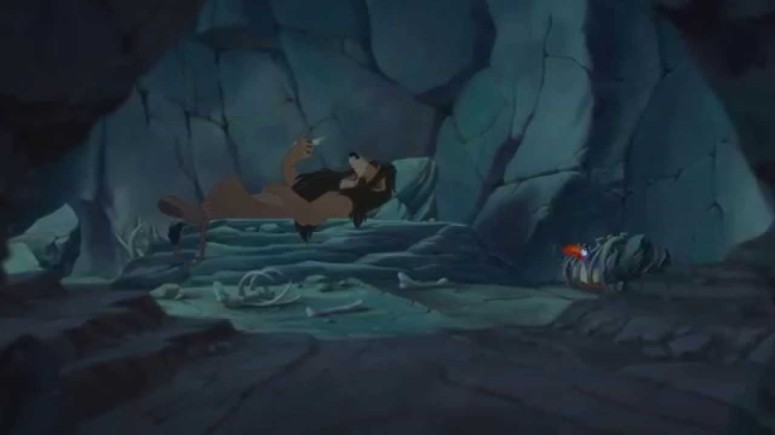 It obviously was discarded given that this scene would develop outside of the realism the filmmakers aspired to accomplish. Instead of showing him captured, it was decided to let our advisor roam free and assist other characters in this barren land. His most notable accomplishment was when he assisted Nala in escaping Pride Rock, so she could find help. This leads to the acknowledgement of Simba’s existence.
It obviously was discarded given that this scene would develop outside of the realism the filmmakers aspired to accomplish. Instead of showing him captured, it was decided to let our advisor roam free and assist other characters in this barren land. His most notable accomplishment was when he assisted Nala in escaping Pride Rock, so she could find help. This leads to the acknowledgement of Simba’s existence.
Screen Time Priorities
In a twist of events, I can only come to one conclusion. The conclusion: the filmmakers want the audience to be omniscient. How do I reach this conclusion? Simple, I call it screen time priorities. The filmmakers used precious screen time to demonstrate exactly how Rafiki was informed of Simba’s existence. Our adolescent lion scratches himself before falling asleep next to Timon and Pumba; this shakes loose a waft of hair that proceeds to float through time and space. just to inform Rafiki that Simba was still alive.  Minutes and minutes of screen time was used to watch this unnecessary journey. It eventually gets ate by a giraffe. Time passes and then a Dung Beetle starts rolling it up in a pile of defecation. Rafiki then comes along and picks out the hair. As this hair journeyed throughout time and space, I couldn’t help but laugh. I couldn’t believe they were wasting precious screen time for such a frivolous matter. Thus, I can only assume the filmmakers want to fill-in a perceived “plot hole.” This unnecessary waste of time does answer the question “how did Rafiki come to the conclusion that Simba was alive.” The bottomline is that Rafiki is a crazy, yet wise baboon.
Minutes and minutes of screen time was used to watch this unnecessary journey. It eventually gets ate by a giraffe. Time passes and then a Dung Beetle starts rolling it up in a pile of defecation. Rafiki then comes along and picks out the hair. As this hair journeyed throughout time and space, I couldn’t help but laugh. I couldn’t believe they were wasting precious screen time for such a frivolous matter. Thus, I can only assume the filmmakers want to fill-in a perceived “plot hole.” This unnecessary waste of time does answer the question “how did Rafiki come to the conclusion that Simba was alive.” The bottomline is that Rafiki is a crazy, yet wise baboon.

The audience doesn’t need an explanation for how he comes to know the things he does. He is a character from left field, and as such we can take his knowledge at face value, the tellings of a crazy old man. We don’t need to watch the journey this waft of hair takes. It’s just laughable
While we are talking about Rafiki, let’s discuss the absence of his iconic moment. An iconic life lesson
***Rafiki clobbers Simba ontop of the head***
Simba: ow what was that for?
Rafiki: It doesn’t matter, it’s in the past!
— Rafiki ’94
is absent from the film. The alternative doesn’t even pack the punch of the ’94 adaption (pun definitely intended). Instead a CG Rafiki leads Simba to the watering hole and, without clobbering him on the head and in a bland forgettable manner, discusses that the past is the past.  In fact. Timon’s philosophy (that was very briefly mentioned in the film) about being in the present to affect the future is more memorable than Rafiki’s “life lesson.” And Rafiki is supposed to be the wise, albeit crazy, character of the film! The loss of this story beat is just absurd! So, let me get this right… Rafiki can be seen clobbering the hyenas with his staff in the final battle, but he can’t deliver the iconic blow to Simba? This is not acceptable to me. The argument of realism does NOT work here. We clearing see him using it to attack the hyenas. Clobbering a “blind” Simba would have been 100 % necessary.
In fact. Timon’s philosophy (that was very briefly mentioned in the film) about being in the present to affect the future is more memorable than Rafiki’s “life lesson.” And Rafiki is supposed to be the wise, albeit crazy, character of the film! The loss of this story beat is just absurd! So, let me get this right… Rafiki can be seen clobbering the hyenas with his staff in the final battle, but he can’t deliver the iconic blow to Simba? This is not acceptable to me. The argument of realism does NOT work here. We clearing see him using it to attack the hyenas. Clobbering a “blind” Simba would have been 100 % necessary.
Okay, now that I have finished my tangent, let’s talk about the unnecessary use of flashbacks. Upon Scar and Simba’s final confrontation, Scar mentions the death of Mufasa. This stirs a flashback. We see the exact same scene, of Mufasa falling from the cliff, from Simba’s point of view. This flashback does not add anything to the story; it doesn’t reveal any new information, all it does is interrupt the coming battle. As a result, it wastes screen time. I’m just not a fan. It takes well delivered, impertinent, parallel styled flashbacks to catch my eye. Aside from these stylized flashbacks, I think this method is consistent with “lazy” storytelling. I thought a remake of this caliber would demonstrate better storytelling techniques, but I guess blockbusters commit these sins more than any other.
Pop-Culture
Pop-culture plays a large role in a film’s success. If you look at the 1992 Aladdin you can see the full influence of Robbin William’s Genie. In this animated classic, anachronisms pop up everywhere and contribute significantly to the success of this Disney classic. If you look at the musical number “Prince Ali” you will see it littered with referenced to pop-culture. Disney brings back this feat in the 2019 adaption of The Lion King and I couldn’t be happier. These references show how culture has changed and how film adapts to these changes.
Starting off, lets look at the lyric and dialogue alterations made in Hakuna Mata. In the original ’94 adaption the cast sings
Pumba: Thoughta changin’ my name,
Timon: Oh, what’s in a name?
Pumba: And I got downhearted,
Timon: How did you feel?
Pumba: Every time that I—
Timon: Pumba, not in front of the kid,
Pumba: Oh sorry
— ’94 Hakuna Mata
this added such hilarity when I was younger. I remember when the word “farted” was forbidden. My grandma was a stickler against that term. She considered it a curse word. Instead, we had to use “stinker” as the vernacular substitute for the foul word. Because of this personal experience, I feel confident in saying that during the film’s conception, recording, and distribution it was still socially unacceptable to use this term, especially in a children-oriented-animated feature. Now, fast forward 25 years later and the lyrics are vastly different.
Pumba: I thought of changin’ my name!
Timon: I mean, to what? Brad?
Pumba: And I got downhearted
Every time that I faaarted—
Are you gonna stop me?Timon: No, I’m not. you disgust me!
— ’19 Hakuna Mata
Not only did the word farted get said, but Pumba even asked Timon if he was going to stop him. This hilarious play on words can be explained simply. Timon let Pumba say farted because we, the grown up version of their intended audience 25 years ago, are no longer kids! Absolutely brilliant. Pair that with the fact that culture has changed so much that it has become acceptable for it to be in this PG-13 adaption, and you have cinematic hillarity. Let’s not forget the shade Timon throws at the “Brad’s” out there. It is lines like this that depict Timon as a more cynical and sarcastic character over his predecessor.
How many more pop-culture references can be found in Hakuna Mata? How about 2 more! Towards the conclusion of the song Timon and Pumba blatantly discuss Simba’s transformation. Basically, the comic duo says exactly what we have been saying for decades!
Simba: But we’re just getting in the groove
Timon: No, let’s leave ’em wanting more
Pumba: Yeah, you’ve grown four-hundred pounds since we started—
Timon: Meanwhile, I look exactly the same
— ’19 Hakuna Mata
I don’t even need to explain that one. It’s just gold. Here is one more for you too that just brilliantly depicts the culture of todays society, specifically the singers I have met in my life (love you all! Lets all laugh at this next one together please)
Simba: It means no worries
Timon: Oh, now he’s riffing, Pumbaa, this is a nightmare
Pumba: It actually is kinda getting better
— ’19 Hakuna Mata
This comic duo is the equivalent of what Genie is to Aladdin. Timon and Pumba provide the comedy, the pop-culture references, and extreme loyalty. It is this loyalty that makes for the best kind of sidekicks. You just have to love them. Let us not forget another iconic pop-culture reference. In the original ’94 animated feature Timon and Pumba had to distract the hyenas so Simba could confront Scar.
What do ya want me to do dress in drag and do the hula?”
Lu’au!
— ’94 Hula Dance
For clear reasons, the animators could not use these same references from the ’94 adaption. First and foremost, the over realistic style would not permit these characters to dress up and dance in such a manner, especially now considering how often they made Timon scratch himself. Secondly, and arguably, in today’s social and political climate making such a Laissez-faire comment regarding dressing the drag and dancing the hula could potentially ruffle some feathers. Instead the storytellers opted for a different, relevant, yet comic approach.
Ma chère mademoiselle, we proudly present… your dinner.
Be. Our. Gue – ahhhh!
— ’19 The Lion King
This alternative form of comedy still presents Pumba as the meal to be served up to the hyenas. In that regard, it additionally poses as a form of clever comedy. The fact that it also pays homage to another Disney classic also deserves immense recognition (even if I hate the live action rendition of Beauty and the Beast, that is another point altogether and a topic for later).
Musical Numbers
For the most part I was pleased with the musical numbers of the ’19 adaption with a few exceptions. Although the actual song was good, I was disappointed in the lead up to I Just Can’t Wait to be King. I personally felt as though the dialogue was not as witty. In fact, it felt watered down … more words were added for virtually no added affect.
Scar’s one and only song, Be Prepared, became 100% more badass. Although shorter, this darker version was just villainous, a real treat. My only complaint is that I do enjoy the history reference and the minuet character development seen in the ’94 version. Here you see the hyena’s marching to Scar’s tune in a rendition awfully similar to Hitler’s reign.  The unspoken comparison truly shows Scar’s true character and villainy. It is seeing comparisons like this that assists in the argument that Scar is one of the worst Disney villains of all time. I just always thought it was neat that this historical allusion was placed in a Disney film and the fact that it assisted in a subconscious development was just icing on the cake. This image itself speaks volumes. gives chills. I miss having it in the ’19 adaption. I will admit that with the new development of the hyenas and Shenzi, it wouldn’t make sense for a scene like this to be depicted. So although I appreciate it, I guess it is only fitting that it stays in the 1994 classic.
The unspoken comparison truly shows Scar’s true character and villainy. It is seeing comparisons like this that assists in the argument that Scar is one of the worst Disney villains of all time. I just always thought it was neat that this historical allusion was placed in a Disney film and the fact that it assisted in a subconscious development was just icing on the cake. This image itself speaks volumes. gives chills. I miss having it in the ’19 adaption. I will admit that with the new development of the hyenas and Shenzi, it wouldn’t make sense for a scene like this to be depicted. So although I appreciate it, I guess it is only fitting that it stays in the 1994 classic.
The staging in Be Prepared (2019) is on point too. As the song escalates, the villainous Scar ascends the cliff ledges, not because he wants to put distance between himself and the hyenas, but because he is symbolicly displaying his climb for power, his desire to ascend in the ranks of the hierarchy.
Now that I think about it, the new ’19 adaption of the song is reminiscent of The Jungle Book‘s “I Wanna Be Like You” from Disney’s 2016 adaption. The tonality and darkness are eerily similar.
Finally, the time has come. I am here to discuss the iconic musical number Can You Feel The Love Tonight featuring Beyonce and Donald Glover.
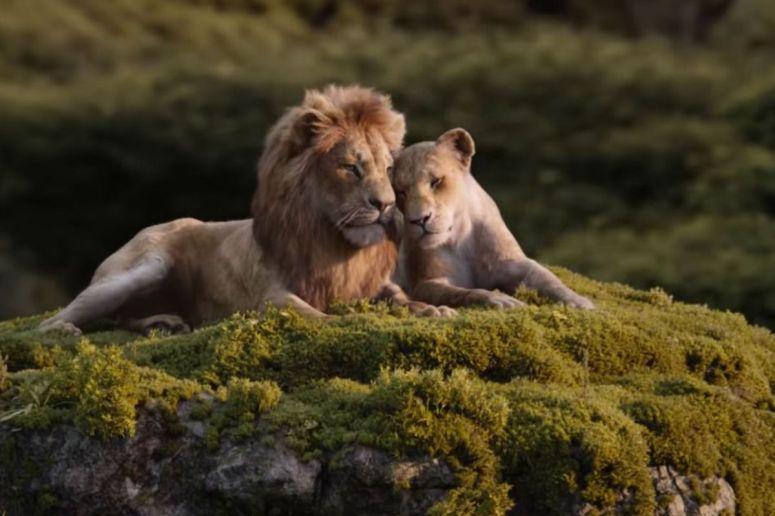
The song everyone has been anticipating… the song Beyoncé was going to bring to life. It was going to be everything the old song was and more, because Beyoncé was the vocalist. Upon listening to the song, I was hit with immediate disappointment. Can You Feel the Love Tonight is supposed to be a ballad. A soothing tune with emotive properties.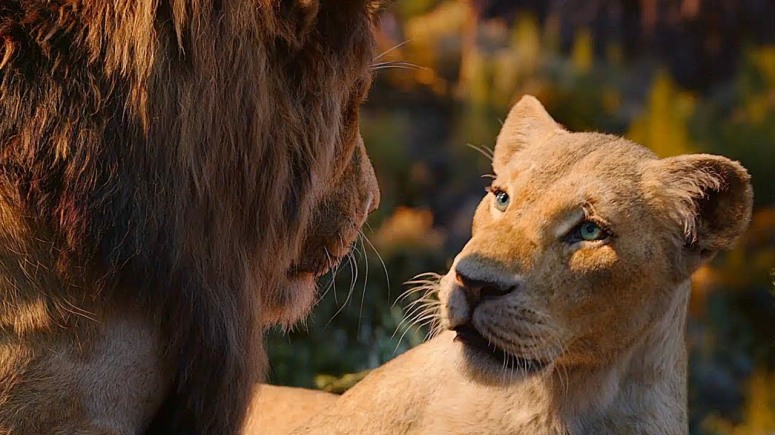 A song reuniting Nala and Simba after years and years apart. Yet, the ’19 rendition did nothing for me. It felt hallow and I sum it up to Beyonce’s attempt at making the song her own. The vibrato distracted from the filmic moment and sadly felt forced. It sounded fabricated and had a stage performance rendition to it. It didn’t depict the emotive scene of best friends, lovers, reuniting. It didn’t feel like it belonged in a film, but was instead a stage performance. The sad fact is … when I only listen to Donald Glover’s part, I love it. When I listen to both vocalists together … I hate it. Sorry Beyoncé, but I think you missed the mark by a long shot. My unpopular opinion: it’s a huge disappointment.
A song reuniting Nala and Simba after years and years apart. Yet, the ’19 rendition did nothing for me. It felt hallow and I sum it up to Beyonce’s attempt at making the song her own. The vibrato distracted from the filmic moment and sadly felt forced. It sounded fabricated and had a stage performance rendition to it. It didn’t depict the emotive scene of best friends, lovers, reuniting. It didn’t feel like it belonged in a film, but was instead a stage performance. The sad fact is … when I only listen to Donald Glover’s part, I love it. When I listen to both vocalists together … I hate it. Sorry Beyoncé, but I think you missed the mark by a long shot. My unpopular opinion: it’s a huge disappointment.
Conclusion
The conclusion of the film is reminiscent of the 1994 original classic. The circle of life is reinstated, and peace and harmony flows over the pride lands once again. It resembles Mufasa’s rein, yet our liege is the one and only Simba. It is a happily ever after with the presentation of a new cub, Simba and Nala’s heir. The story comes round circle in a display that truly is a reflection of the circle of life. The symbolism is strong in this film. Although the filmmakers stayed as close to the original as possible, they also took steps to make the story their own. They added new comedic beats, pop-culture references, and further developed Scar. Scar’s backstory was excellently executed in this new adaption. Although I had many disappointments, I also felt gratitude for the laughs I was able to share with my family.
I didn’t hate it … in fact, I kind of liked it, which is a huge change from my reactions to all of the recent live action remakes. I would maybe watch this film again.
Cheers to the cast and crew.
The Lion King animated classic was first released on June 24, 1994. The live action remake was released 25 years later on July 9, 2019.
